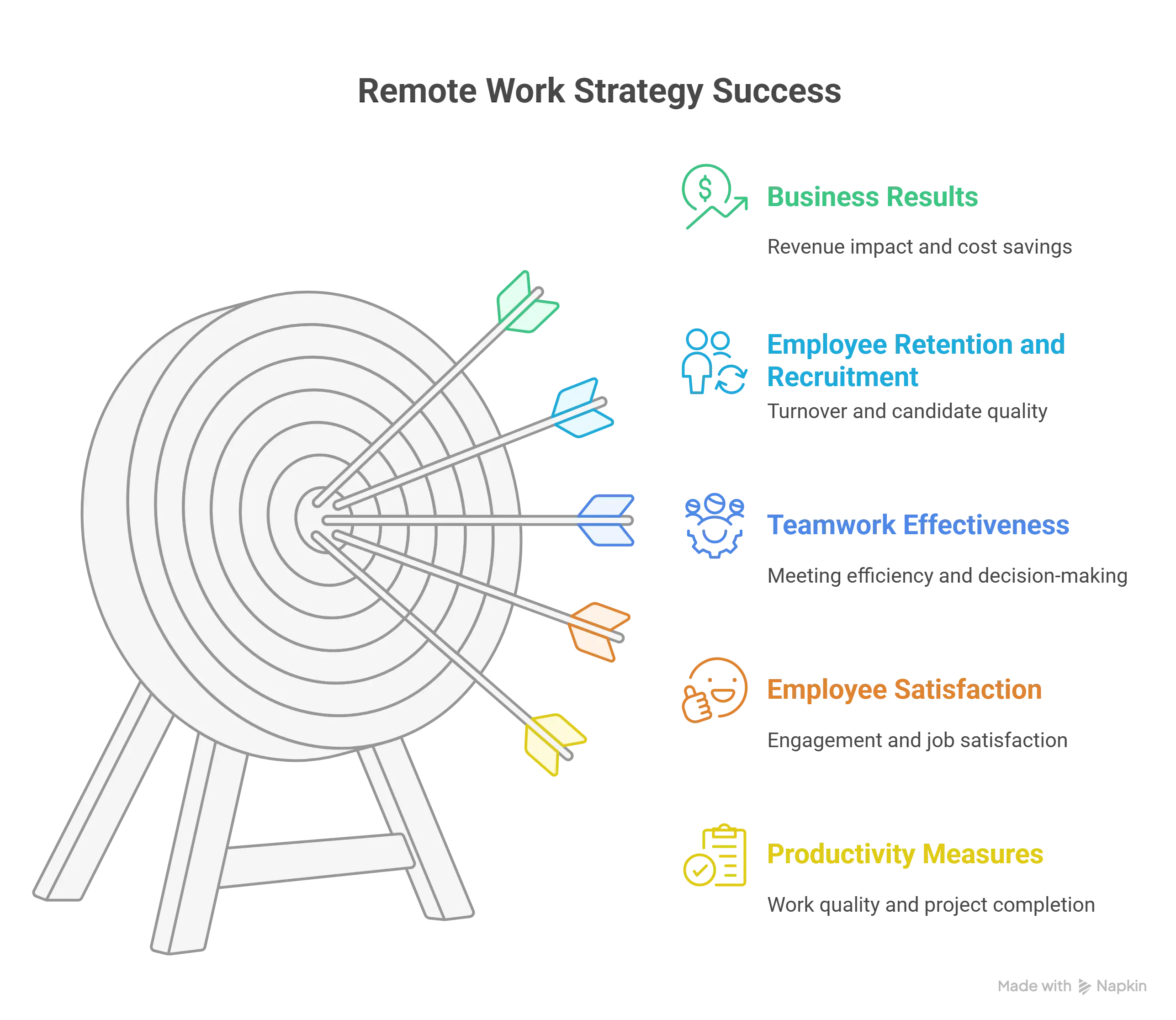
Remote work strategy has changed from a quick fix during the pandemic to a real business advantage. Companies that master remote work strategies don't just survive—they grow by finding better talent, cutting costs, and building stronger teams.
The numbers are clear: approximately 28% of employees worldwide worked remotely in 2023, up from 20% in 2020. Yet many companies still don't have a solid remote working strategy. Here's your complete guide to building effective strategies for remote work that get real results.
Good remote work strategies start with clear goals and ways to measure success. Unlike regular office work, remote work needs careful planning for communication, tracking work quality, and keeping employees engaged.
Your work from home strategy should cover these main areas:
| Strategy Part | Main Focus | How to Measure Success | Time Needed |
|---|---|---|---|
| Technology Setup | Safe access, teamwork tools, tracking performance | System uptime, how many people use it | 0-30 days |
| Communication Rules | Meeting schedule, message systems, feedback | How fast people respond, engagement scores | 30-60 days |
| Managing Performance | Setting goals, tracking work, recognizing good work | Work quality, meeting deadlines | 60-90 days |
| Culture & Engagement | Team building, training, employee wellbeing | How many people stay, satisfaction surveys | Ongoing |
The best remote work strategies work well with your current business while solving the unique problems of remote teams. Companies that do well with remote work often have team members who know key tips for being productive while working remotely.
Key Technology Tools for Remote Work Success
Technology is the foundation of any good remote working strategy. Companies that use the right tools see better productivity, teamwork, and happier employees.
Essential technology includes:
- Safe Remote Access Tools - Let employees safely reach company files from anywhere
- Cloud Collaboration Platforms - Help teams share documents and manage projects in real-time
- Video Meeting Systems - Support face-to-face talks and team building
- Work Tracking Tools - Monitor productivity without being too controlling
- Security Systems - Protect important data across all devices
Today's companies are using complete solutions that combine multiple functions. According to research from the U.S. Bureau of Labor Statistics, industries with higher remote work adoption showed positive productivity growth, with companies experiencing better total factor productivity when employees work from distributed locations compared to traditional office-only setups.
Creating Good Remote Communication Plans
Great communication is what separates successful remote teams from struggling ones. Your remote work strategy needs clear rules for different types of talks and sharing information.
Good communication plans usually include:
- Real-Time Communication
- Daily check-ins to align on projects
- Weekly team meetings for bigger updates
- Monthly company-wide meetings
- Quarterly planning sessions
- Non-Real-Time Communication
- Project updates through shared documents
- Decision records in central systems
- Feedback through organized forms
- Knowledge sharing through company wikis
Companies with organized communication plans make decisions 60% faster and complete projects much better. The key is setting clear expectations about response times and which channels to use for different types of information.
Managing Performance and Responsibility in Remote Work
Old ways of managing performance often don't work for remote teams. Good strategies for remote work focus on results rather than activities. This means leaders need to change how they measure and manage performance.
Key parts of good remote performance management:
- Results-Based Goal Setting - Create clear, measurable goals tied to business results
- Regular Check-ins - Schedule consistent one-on-ones to provide help and remove roadblocks
- Clear Progress Tracking - Use shared dashboards to stay updated without micromanaging
- Skills Growth Focus - Make continuous learning and career growth a priority
- Recognition Systems - Have organized ways to acknowledge good work
Many companies succeed by combining technology with people-focused approaches. Understanding current trends in remote-friendly industries can help set performance expectations and career growth opportunities.
Building Strong Remote Culture and Employee Engagement
Remote work culture needs intentional effort to build. Unlike traditional offices where culture happens naturally through being together, remote teams must actively create shared experiences, values, and connections.
Proven ways to build remote culture include:
- Virtual Team Building - Regular social activities beyond work tasks
- Shared Learning - Group training sessions and knowledge sharing
- Cross-Team Collaboration - Projects that break down department barriers
- Recognition Programs - Public acknowledgment of achievements
- Flexible Work Arrangements - Working with different time zones and personal schedules
Research from leading workplace studies shows that companies with strong remote cultures have 40% better employee retention and 25% better performance than those that just copy in-office practices online.
Security and Following Rules in Remote Work Plans
Security can't be added later in remote work planning. Good strategies for remote work must address cybersecurity, data protection, and following regulations from the start.
Essential security parts include:
- Multi-Factor Authentication - Required for all system access
- VPN or Zero-Trust Setup - Safe network connections
- Device Protection - Security software on all remote devices
- Regular Security Training - Ongoing education about threats and best practices
- Incident Response Plans - Clear steps for security breaches
Companies must also think about rules for their industry and locations. This includes data privacy laws, employment rules, and industry standards that may affect remote work policies.
Measuring Remote Work Strategy Success
Using data helps improve remote work strategies continuously. Successful companies track both number-based metrics and quality indicators to check how well their remote work is going.
Key measures for remote work include:
- Productivity Measures - Work quality, project completion rates, goal achievement
- Employee Satisfaction - Regular surveys measuring engagement and job satisfaction
- Teamwork Effectiveness - Meeting efficiency, decision-making speed, cross-team projects
- Business Results - Revenue impact, cost savings, customer satisfaction
- Keeping and Finding Employees - Employee turnover, time-to-hire, candidate quality
Industry research shows that companies with mature remote work strategies make 21% more profit and have access to talent pools 5x larger than their office-only competitors.

Future-Proofing Your Remote Work Strategy
The remote work world keeps changing fast. Companies must build flexibility into their strategies for remote work to stay competitive and respond to changing worker expectations.
New trends to consider include:
- Hybrid Work Models - Flexible mixes of remote and in-office work
- AI-Enhanced Productivity - Automation tools that improve remote work efficiency
- Global Talent Access - Plans for hiring across international borders
- Sustainability Focus - Environmental benefits as a strategic advantage
- Mental Health Priority - Complete wellbeing programs for remote workers
Forward-thinking companies are also investing in professional development that helps their teams adapt to remote work changes. Many teams benefit from understanding how to build and maintain professional relationships in virtual environments.
Remote Work Strategy Implementation Plan
Successful implementation needs step-by-step approaches with clear milestones. Companies that try to implement complete remote work strategies overnight often struggle with adoption and effectiveness.
Recommended implementation steps:
- Phase 1 (Weeks 1-4): Foundation Building
- Technology setup
- Security measures implementation
- Basic communication guidelines
- Phase 2 (Weeks 5-8): Process Improvement
- Performance management systems
- Team collaboration workflows
- Training program rollout
- Phase 3 (Weeks 9-12): Culture Development
- Team building activities
- Recognition programs
- Feedback collection and improvements
- Phase 4 (Ongoing): Continuous Improvement
- Performance monitoring and optimization
- Strategy improvements based on data
- Adaptation to new trends
According to research from leading business experts, companies that follow organized implementation approaches reach their remote work goals 3x faster than those that use random methods.
Common Questions
What are the most important parts of a successful remote work strategy?
The most important parts include strong technology setup, clear communication rules, results-based performance management, strong security measures, and intentional culture building. Companies must also set measurable goals and continuous feedback loops to make sure the strategy works.
How do you measure the return on investment of remote work strategies?
ROI measurement should include productivity metrics (work quality and quantity), cost savings (less office space, travel, utilities), employee satisfaction scores, retention rates, and business results like revenue growth. Most companies see positive ROI within 6-12 months of implementing complete remote work strategies.
What are the biggest challenges in implementing remote work strategies?
Common challenges include keeping team unity, ensuring consistent communication, managing performance across different time zones, cybersecurity concerns, and keeping company culture. Success requires addressing each challenge with specific policies and tools rather than hoping they fix themselves.
How do remote work strategies differ for small businesses versus large companies?
Small businesses typically need simpler, cost-effective solutions with focus on essential tools and clear processes. Large companies need more complex infrastructure, compliance considerations, and change management approaches. However, both benefit from focusing on communication, performance results, and employee engagement.
Should remote work strategies include hybrid options?
Most successful remote work strategies include some flexibility, whether fully remote, hybrid, or flexible arrangements. The key is aligning work arrangements with business needs, employee preferences, and practical considerations like collaboration requirements and company culture goals.
How often should companies review and update their remote work strategies?
Remote work strategies should be reviewed every three months for small adjustments and every year for big updates. However, companies should continuously watch key metrics and be ready to make quick adjustments based on employee feedback, technology changes, or business requirement shifts.